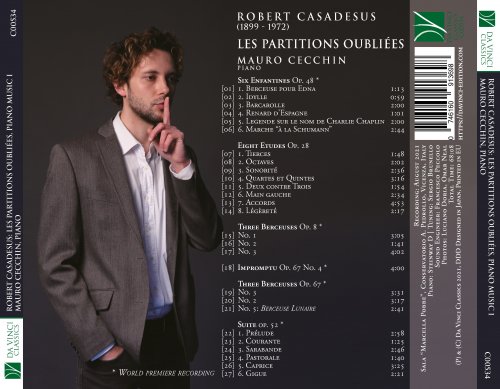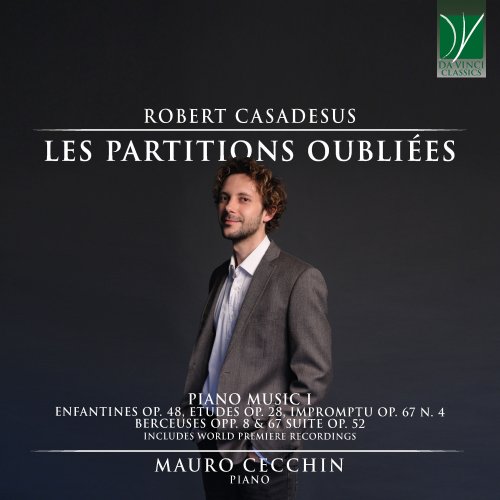
Mauro Cecchin - Robert Casadesus: Les partitions oubliées, Piano Music I (Enfantines Op. 48, Etudes Op. 28, Impromptu Op. 67 No.4, Berceuses Opp. 8 & 67, Suite Op. 52) (2022)
BAND/ARTIST: Mauro Cecchin
- Title: Robert Casadesus: Les partitions oubliées, Piano Music I (Enfantines Op. 48, Etudes Op. 28, Impromptu Op. 67 No.4, Berceuses Opp. 8 & 67, Suite Op. 52)
- Year Of Release: 2022
- Label: Da Vinci Classics
- Genre: Classical Piano
- Quality: flac lossless (tracks)
- Total Time: 01:08:12
- Total Size: 206 mb
- WebSite: Album Preview
Tracklist
01. Six Enfantines, Op. 48: No. 1, Berceuse pour Edna
02. Six Enfantines, Op. 48: No. 2, Idylle
03. Six Enfantines, Op. 48: No. 3, Barcarolle
04. Six Enfantines, Op. 48: No. 4, Renard d'Espagne
05. Six Enfantines, Op. 48: No. 5, Legende sur le nom de Charlie Chaplin
06. Six Enfantines, Op. 48: No. 6, Marche “à la Schumann”
07. Eight Etudes, Op. 28: No. 1, Tierces
08. Eight Etudes, Op. 28: No. 2, Octaves
09. Eight Etudes, Op. 28: No. 3, Sonorité
10. Eight Etudes, Op. 28: No. 4, Quartes et Quintes
11. Eight Etudes, Op. 28: No. 5, Deux contre Trois
12. Eight Etudes, Op. 28: No. 6, Main gauche
13. Eight Etudes, Op. 28: No. 7, Accords
14. Eight Etudes, Op. 28: No. 8, Légèreté
15. Three Berceuses, Op. 8: No. 1
16. Three Berceuses, Op. 8: No. 2
17. Three Berceuses, Op. 8: No. 3
18. Impromptu, Op. 67 No. 4
19. Three Berceuses, Op. 67: No. 3
20. Three Berceuses, Op. 67: No. 2
21. Three Berceuses, Op. 67: No. 5, Berceuse Lunaire
22. Suite, Op. 52: I. Prélude
23. Suite, Op. 52: II. Courante
24. Suite, Op. 52: III. Sarabande
25. Suite, Op. 52: IV. Pastorale
26. Suite, Op. 52: V. Caprice
27. Suite, Op. 52: VI. Gigue

The idea of collecting in an album some hitherto unrecorded works by Robert Casadesus results from my aim to bring to light the wonderful music by this composer, whose fame as a creator was overshadowed by that as a pianist.
Born in 1899, after obtaining his diploma at the Paris Conservatoire, Robert Casadesus cooperated with composer Maurice Ravel writing the catalogue of the latter’s works, and he gave recitals, sharing the stage with his friend, in France, Spain and England. Many recordings document his concert activity and his art, while recordings of his work as a composer are scanty. He wrote numerous pieces for solo piano, for ensembles, for voice and orchestra. A refined interpreter of French classicism and impressionism, he frequently played in duo with his wife Gabrielle L’Hôte (aka Gaby), and also with his son Jean: for them he wrote works for two or three pianos. He taught for many years at the American Conservatory of Fontainebleau, and he lived in America during World War II.
The imprint of Casadesus’ pianism, his story, his large family of artists and his historical context are clearly mirrored in his works. As a pianist, he had uncommon mastery of technique and sound, as well as a deep knowledge of polyphony and of the style and sense of form. Therefore, starting from Classical, Baroque, and Romantic forms, this composer unchained his creative energy, inserting, within “cultivated” music, at times some very interesting folklike elements, at times citations from the art music of other composers.
Also as regards the research of sonority and the use of pedal, an interesting interpretive key for Casadesus’ own works comes precisely from listening to his performances, in particular as concerns the works by Debussy and Ravel. Pentatonic scales, an abundant use of parallel fourths and fifths (to which he dedicates one of his Studies), sensitivity and care for the detail as concerns dynamic and agogic indications: all this leads even the most daring harmonies not to become mere effects, but rather to insert themselves and to find their motivations within a long-duration sonorous context. This brings us to deduce the French composer’s clear comprehensive vision and his ability in the management of form.
This composer was fond of monothematicism as a technique: even one single melodic cell could become the thematic material of an entire piece. A thematic cell, as is natural, expresses a concept. The choice of the notes composing it constitutes its essence. Indeed, in some pieces, the letters of the dedicatee’s name become the theme.
His studies are not mere technical exercises: just as the lyrical pieces, they require particular attention to the sound, listening to harmonies, and a careful use of pedals.
In all works by Casadesus contained in this album one finds, alive, Robert the pianist, the virtuoso, the artist.
This all required from the performer an uncompromising precision and awareness of the composer’s style (not only as a composer but also as a performer), as well as a humble and faithful approach to the text. This frequently displays very precise indications; however, beyond them, there is much more content one should analyze, synthesize, interpret...
01. Six Enfantines, Op. 48: No. 1, Berceuse pour Edna
02. Six Enfantines, Op. 48: No. 2, Idylle
03. Six Enfantines, Op. 48: No. 3, Barcarolle
04. Six Enfantines, Op. 48: No. 4, Renard d'Espagne
05. Six Enfantines, Op. 48: No. 5, Legende sur le nom de Charlie Chaplin
06. Six Enfantines, Op. 48: No. 6, Marche “à la Schumann”
07. Eight Etudes, Op. 28: No. 1, Tierces
08. Eight Etudes, Op. 28: No. 2, Octaves
09. Eight Etudes, Op. 28: No. 3, Sonorité
10. Eight Etudes, Op. 28: No. 4, Quartes et Quintes
11. Eight Etudes, Op. 28: No. 5, Deux contre Trois
12. Eight Etudes, Op. 28: No. 6, Main gauche
13. Eight Etudes, Op. 28: No. 7, Accords
14. Eight Etudes, Op. 28: No. 8, Légèreté
15. Three Berceuses, Op. 8: No. 1
16. Three Berceuses, Op. 8: No. 2
17. Three Berceuses, Op. 8: No. 3
18. Impromptu, Op. 67 No. 4
19. Three Berceuses, Op. 67: No. 3
20. Three Berceuses, Op. 67: No. 2
21. Three Berceuses, Op. 67: No. 5, Berceuse Lunaire
22. Suite, Op. 52: I. Prélude
23. Suite, Op. 52: II. Courante
24. Suite, Op. 52: III. Sarabande
25. Suite, Op. 52: IV. Pastorale
26. Suite, Op. 52: V. Caprice
27. Suite, Op. 52: VI. Gigue

The idea of collecting in an album some hitherto unrecorded works by Robert Casadesus results from my aim to bring to light the wonderful music by this composer, whose fame as a creator was overshadowed by that as a pianist.
Born in 1899, after obtaining his diploma at the Paris Conservatoire, Robert Casadesus cooperated with composer Maurice Ravel writing the catalogue of the latter’s works, and he gave recitals, sharing the stage with his friend, in France, Spain and England. Many recordings document his concert activity and his art, while recordings of his work as a composer are scanty. He wrote numerous pieces for solo piano, for ensembles, for voice and orchestra. A refined interpreter of French classicism and impressionism, he frequently played in duo with his wife Gabrielle L’Hôte (aka Gaby), and also with his son Jean: for them he wrote works for two or three pianos. He taught for many years at the American Conservatory of Fontainebleau, and he lived in America during World War II.
The imprint of Casadesus’ pianism, his story, his large family of artists and his historical context are clearly mirrored in his works. As a pianist, he had uncommon mastery of technique and sound, as well as a deep knowledge of polyphony and of the style and sense of form. Therefore, starting from Classical, Baroque, and Romantic forms, this composer unchained his creative energy, inserting, within “cultivated” music, at times some very interesting folklike elements, at times citations from the art music of other composers.
Also as regards the research of sonority and the use of pedal, an interesting interpretive key for Casadesus’ own works comes precisely from listening to his performances, in particular as concerns the works by Debussy and Ravel. Pentatonic scales, an abundant use of parallel fourths and fifths (to which he dedicates one of his Studies), sensitivity and care for the detail as concerns dynamic and agogic indications: all this leads even the most daring harmonies not to become mere effects, but rather to insert themselves and to find their motivations within a long-duration sonorous context. This brings us to deduce the French composer’s clear comprehensive vision and his ability in the management of form.
This composer was fond of monothematicism as a technique: even one single melodic cell could become the thematic material of an entire piece. A thematic cell, as is natural, expresses a concept. The choice of the notes composing it constitutes its essence. Indeed, in some pieces, the letters of the dedicatee’s name become the theme.
His studies are not mere technical exercises: just as the lyrical pieces, they require particular attention to the sound, listening to harmonies, and a careful use of pedals.
In all works by Casadesus contained in this album one finds, alive, Robert the pianist, the virtuoso, the artist.
This all required from the performer an uncompromising precision and awareness of the composer’s style (not only as a composer but also as a performer), as well as a humble and faithful approach to the text. This frequently displays very precise indications; however, beyond them, there is much more content one should analyze, synthesize, interpret...
Year 2022 | Classical | FLAC / APE
As a ISRA.CLOUD's PREMIUM member you will have the following benefits:
- Unlimited high speed downloads
- Download directly without waiting time
- Unlimited parallel downloads
- Support for download accelerators
- No advertising
- Resume broken downloads


